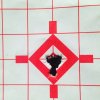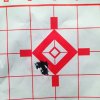I think we would all agree: intended use is the primary aspect of choosing a barrel:
I am sure there are hunters out there who would be happy if their 300WM weighed 2lbs complete and would be happy to accept the unshod mule kick it will deliver.
Bench rest-it appears heavy is better.
ELR- while the barrels are heavy (20+ pds at times) their length proportionally makes them a lighter contour.
And everything in between.
Is it a one shot cold bore is the criteria, 3 shots, 5 shots, 20rds competition, fire fight unlimited. Each brings their own requirements. Trade offs and compromise.
Fluting does not make a barrel inherently stronger.
It adds a minimal of surface area for cooling unless drastic fluting is employed- back to weaker.
Our designs are focusing on extended competitions and engagements. A note that heavier barrels do have wider nodes, a concept that as of this date we agree with. The wider nodes make load development easier, a more forgiving rifle to shoot in a wider range of environments.
By weight structures are stronger than solids of their same weight. In our case significantly stiffer. We also have well north of more than 300% greater cooling surface. How much does it weigh? Our 300N barrel is 32 x 1.45D and weight 7.2lbs. We don't think about heat until north of 20 round strings. If it is cool outside... keep shooting. We test 25-50 round strings for group size, drift and SD variation.
The images shown are a ladder test from a .375CT. Ten grains in 1/2gr increments. Look at the groups: that is the 20rds with one adjustment to put the rifle on zero. This ladder test also represents round 8 through 28 through this barrel. This is quite common. Six more rounds were shot thru the barrel for prove out out to 2Kyds. Then it went to South Africa and was used to take 3rd and 4th place in K2K and K2M.
Please look at our simulations: you will see tests on barrels not seen before.







